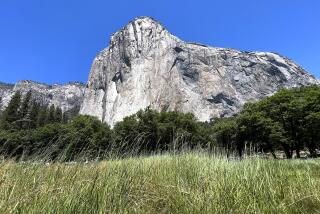Critics Decry Decision on Forest
- Share via
WASHINGTON — The Bush administration has recommended against expanding the number of federally protected acres in Alaska’s Tongass National Forest, where vast areas are already protected from logging, road building and other development.
In a proposal released Thursday, the administration recommended that Congress not add to the 6.6 million acres that lawmakers have already given special status in the world’s largest intact temperate rain forest.
Officials from the U.S. Forest Service had evaluated expanding the protected area by as much as 9 million acres, in response to a federal court order.
At the same time, however, the administration recommended that Congress designate as wilderness 1.4 million acres of Alaska’s Chugach National Forest, near Anchorage.
The Tongass--a puzzle of islands and stretch of mainland that make up most of Alaska’s panhandle--is a recreational area for anglers, whose only access to some of the world’s best salmon and trout fishing is by seaplane.
The fate of its vast old-growth forests--home to grizzly bears, wolves and other wildlife--has attracted the attention of environmentalists around the world because half of the world’s temperate rain forests already have been logged.
Forty percent of the world’s remaining temperate rain forests--ecosystems that draw their sustenance from the constant cycling of water between land and sea--are in Alaska.
“Future generations will ask how, in 9.4 million acres of the world’s last intact temperate rain forest, the Bush administration didn’t see one acre worth preserving as wilderness,” said Deidre McDonnell, an attorney with Earthjustice.
The national environmental group, arguing on behalf of several environmental groups, won the case against the government that resulted in the judge’s order.
But Alaska’s flagging timber industry also prizes the Tongass’ thick forests of hemlock and spruce, and the health of the industry relies on its ability to continue logging there.
“I think they made the right decision,” said Owen Graham, executive director of the Alaska Forest Assn. “There’s already such a vast amount of the Tongass set aside.”
The fate of the Tongass forest has emerged as the biggest test of the Bush administration’s pledge to uphold “roadless values.” And environmentalists said the proposal not to designate any additional wilderness in the Tongass is the strongest signal yet that the Bush administration is not committed to keeping backwoods areas wild.
Michael Francis, a forest specialist for the Wilderness Society, said the White House’s position that it supports roadless policy is nothing but a “ruse.”
“They have no intention of protecting wild forests for future generations,” he said.
The Clinton administration planned to protect these forests as part of its sweeping plan to ban new road building and commercial logging in 58.5 million acres of national forests across the country.
Agriculture Secretary Ann Veneman, who runs the Forest Service, pledged soon after assuming office to uphold “roadless values,” while announcing plans to alter aspects of the Clinton regulations.
But the administration has been quietly moving away from that by forging ahead with timber sales in roadless areas, including 33 in the Tongass.
A federal judge blocked implementation of that plan in May 2001, saying that the Clinton administration had violated the National Environmental Policy Act in enacting the rule. An appeal is pending.
In the meantime, the administration is crafting its own version of a roadless plan.
“Being committed to roadless values does not necessarily mean we decide to retain every acre in its current condition,” said Mark Rey, the undersecretary of the Agriculture Department with responsibility for the Forest Service.
“It means being committed to the ecological and environmental benefits of keeping these areas largely undeveloped.”
Rey said the Tongass wilderness proposal does not signal the administration’s plan for the 9 million acres of roadless area in the forest.
The administration’s roadless policy and its final management plan, both expected later this year, will spell out the fate of those acres, Rey said.
Rey said the bigger announcement was the recommendation to set aside almost a quarter of Chugach National Forest as a wilderness area, which would prohibit most development.
“These acres are a world-class scenic and ecological treasure that deserve wilderness protection,” he said.
In the Wilderness Act of 1964, Congress defined wilderness as “an area where the Earth and its community of life are untrammeled by man, where man himself is a visitor who does not remain.”
Since then, Congress has set aside more than 100 million acres of land as wilderness, allowing it to retain its “primeval character.”
More to Read
Sign up for Essential California
The most important California stories and recommendations in your inbox every morning.
You may occasionally receive promotional content from the Los Angeles Times.













